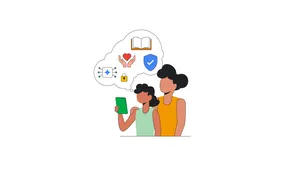How we support young people growing up in the digital age

We believe technology can empower kids, teens and families to safely explore, grow and learn online. Over the past few years, we have been focused on delivering high-quality and age-appropriate online experiences. We also recognize that how a younger child engages with and understands technology is vastly different from a teen’s experience — and we respect that every family has its own relationship with technology.
Today, we’re convening experts from industry, academia, government and civil society at the “Growing Up in the Digital Age” summit hosted at the Google Safety Engineering Center (GSEC) in Dublin. Our goal is to continue the dialogue around important topics when it comes to the protection of young people online, including strengthening privacy and safety, promoting healthy digital habits and helping teens and families navigate new technologies like AI confidently and safely.
At the summit, we’ll also be sharing the latest on how we’re collaborating with experts in this space and what we’ve learned from those partnerships, as well as providing updates on our safeguards, tools and tailored experiences for families. Below are some of the highlights.
Collaborating with others to empower kids and teens online
We have a long history of working with partners — including third party child development specialists, educators, researchers and NGOs — to support the empowerment and safety of kids and teens online.
To advance media literacy and expand online safety initiatives in Europe, last year, Google.org provided more than €8M in grant funding for NGOs, with a focus on supporting underserved youth, including refugees, young people with learning disabilities and those from marginalized communities or in rural or remote areas. We estimate these initiatives to reach 2.7 million young people in Europe. The grants include support for Barnardos in Ireland to extend the reach and scope of their Online Safety Programme for kids and teens with updated content on the topic of AI, and Génération Numérique in France to educate 15,000 underserved teenagers on AI and misinformation.
This year, Google.org is committing an additional €5M with the goal of helping teens understand AI so they can use it safely, as part of Google.org’s commitment earlier this year to support AI training and skills in Europe. We will support organizations who focus on reaching teens who are most underserved as well as their support networks, such as educators and parents.
We’re also excited about the opportunity to collaborate with the United Nations Children’s Fund (UNICEF) in the future on research to explore both how stakeholders across the industry and civil society view and can better support implementing the best interests of the child in digital environments. We look forward to sharing more information in the coming weeks.
Prioritizing child safety
For years, we’ve partnered with researchers, civil society and other companies and organizations in the child safety space. Our child safety toolkit is used by numerous partners, including the National Center for Missing and Exploited Children (NCMEC), to identify potentially harmful content across billions of files, and enables them to evaluate millions of images and videos for abusive behavior each year. We also offer a specific child safety channel within our Priority Flagger Program for qualified organizations, such as NGOs, so that they can notify us of potentially harmful content that violates our policies and Community Guidelines. Finally, we support research in this space, for example, through the T&S Research Grant, enabling academics to study and propose solutions to better protect children.
Helping families navigate the digital world and new technologies
We’re always looking for more ways we can help families find the right balance with technology. A key part of that is providing parents with tools and resources to both manage their kid’s time online and have discussions about the benefits and challenges of technology.
Through Family Link, we provide easy-to-use controls and tools to help parents set the digital ground rules for their kids, so they can do things like set screen time limits, manage apps or check where their child is on the way home from school with just a few quick clicks. Recently, we made it even easier for parents to view and update their child’s settings. When logged into their Google Account, parents simply have to search for “parental controls” and a dedicated information box will appear listing their kids’ accounts with quick links to each supervised account’s settings.
Everything we do for kids, teens and families is created to empower, designed to respect and built to protect. We look forward to continuing this critical work in close collaboration with experts in this space.







